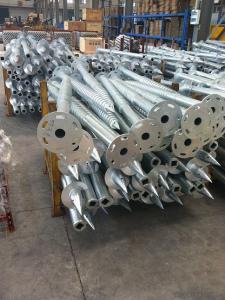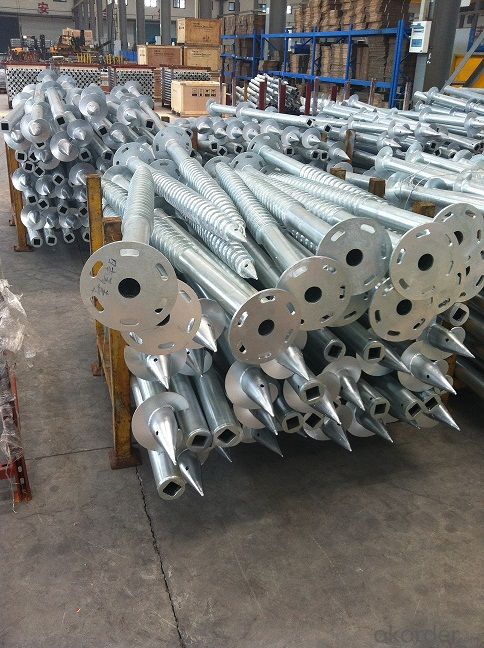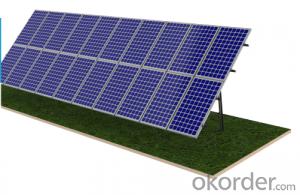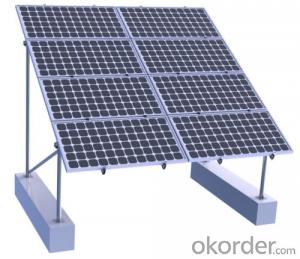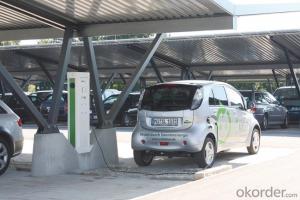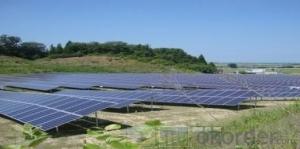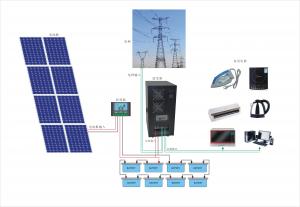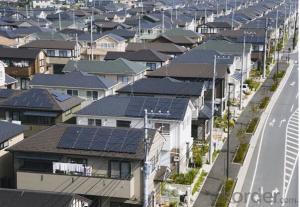Pv Max Solar Energy Systems - Ground System Solar Mounting System
- Loading Port:
- China Main Port
- Payment Terms:
- TT OR LC
- Min Order Qty:
- -
- Supply Capability:
- -
OKorder Service Pledge
OKorder Financial Service
You Might Also Like
Packaging & Delivery
Packaging Detail:Normal package seaworthy
Delivery Detail:15 days
Specifications
Easy installation Competitive price TUV&SGS test report & CSA certification 15-warranty
Specifications
1) Super smooth beautiful appearance,outstanding quality,large supply.
2) Available in customized surface finishes.
3) Well machined,for example,cutting,drilling and milling with excellent tolerance.
4) Meet with customer’s designs and supply you best price.
5)Usages:Supply for solar panel modules.
Technical characteristics
Installation site:
ground,hillside,and grassland
Installation angle
it is based on customers’ requirements
Installation height
it is basedon customers’ requirements
Solar panel type; with or without frame
Components arrangement :horizontal or vertical
Support track
aluminum alloy extrusion
Quality warranty
15 years
Advantages
1)Quick installation: with high degree of pre-installed rate, the system could be easily installed by using galvanized carbon steel rails for PV Stent, and specially designed connection parts of the PV bracket, which could reduce installation time and cost greatly.
2)Offer unmatched durability: with all structural components comprised of high class stainless steel and anodized aluminum alloy, it is designed for 25 years service life and backed by 15 years warranty.
3)Stand up to extreme weather: The SuninTek solar mount is designed to stand up to the extreme weather complied with the AS/NZ 1170 and other international structure load standard by the skilled engineer. The main support components also have been tested to guarantee its structure and load-carrying capacity.
4)Provide broad installation flexibility: These systems accommodate most commercially available framed solar panels , and they can scale easily from small to large, multi-megawatt installations.
5)Diversified Application: The PV mounting system produced can be adopted by various types of PV cells panels which you can find in the market. It can serve for both mini solar power system and huge plant with megawatt capability.
Main features
1. Installation cost savings.
2. Save installation time.
3. Increase the mechanical strength of solar energy mounting to ensure that wind requirements.
4. The outdoor for installation of solar energy.
5. Length can be customized according to customers.
6. Service life of up to 25 years.
7. Products through the international certification.
8. Stent material composition of the galvanized steel and aluminum.
9. 15 years system and structural guarantee.
10.Flexible post spacing withstands different wind & snow loads.
11. High quality material in Aluminium 6005-T5 and SUS 304.
12.Screws and nuts go with every components needed.
13.Mechanical calculation and reliability tested to ensure highest product quality.
- Q: Can solar energy systems be used for powering electric vehicle solar charging stations at highways?
- Yes, solar energy systems can be used to power electric vehicle solar charging stations at highways. Solar panels can be installed along the highways or at charging stations to harness sunlight and convert it into electricity. This renewable energy can then be used to charge electric vehicles, providing a sustainable and environmentally friendly solution for transportation.
- Q: How can I calculate the size of a solar energy system for my home?
- To calculate the size of a solar energy system for your home, you need to consider a few factors. First, determine your average monthly electricity usage in kilowatt-hours (kWh). You can find this information on your utility bills or by contacting your electricity provider. Next, consider your location and the amount of sunlight your area receives. The National Renewable Energy Laboratory (NREL) has a helpful online tool called PVWatts that can estimate the solar energy potential in your area. Additionally, take into account the available roof space or land area where you can install solar panels. Finally, consult with a solar installer or use online calculators that consider these factors to determine the appropriate system size for your home. Keep in mind that it's advisable to consult with professionals for accurate and tailored calculations to meet your specific energy needs.
- Q: Can a solar energy system be installed in a residential community with homeowners' association rules?
- Solar energy systems can indeed be installed in residential communities that have homeowners' association (HOA) rules. However, the regulations pertaining to solar panel installation can vary depending on the specific HOA. In certain cases, HOAs may impose restrictions on the type, size, or placement of solar panels. To proceed with the installation of a solar energy system in a residential community governed by HOA rules, homeowners would typically need to adhere to a set of guidelines or obtain approval from the HOA. This process may involve submitting an application, providing detailed plans and specifications of the system, and acquiring the necessary permits. Many HOAs have recognized the advantages of solar energy and have adopted supportive guidelines for solar panel installations. Some HOAs have even revised their rules to facilitate the installation of solar energy systems for homeowners. It is crucial for homeowners to carefully review the specific rules and guidelines of their HOA and establish communication with the association to fully comprehend the requirements and obtain the necessary approvals. In summary, while it is feasible to install a solar energy system in a residential community governed by HOA rules, it is vital to thoroughly examine the specific guidelines and secure approval from the HOA to ensure compliance and a seamless installation process.
- Q: Can solar energy systems be used in all regions?
- Solar energy systems can be used in all regions to some extent. However, the efficiency and effectiveness of solar energy systems may vary depending on factors such as the amount of sunlight available, local climate conditions, and geographical location. Regions with abundant sunlight and favorable weather conditions tend to be more suitable for harnessing solar energy efficiently. Nonetheless, advancements in solar technology and the availability of storage solutions are continuously improving the viability of solar energy systems in a wider range of regions.
- Q: What is the impact of hurricanes on solar panels?
- The impact of hurricanes on solar panels can be significant. Strong winds and flying debris during a hurricane can cause physical damage to the panels, leading to cracks, breakages, or even complete destruction. Additionally, heavy rain and flooding can damage the electrical components of the panels, reducing their efficiency or rendering them inoperable. Proper installation, maintenance, and storm preparation measures can help minimize the potential damage caused by hurricanes to solar panels.
- Q: How does the cost of solar energy compare to other energy sources?
- The cost of solar energy has become increasingly competitive with other energy sources in recent years. Initially, the high installation costs and limited efficiency of solar panels made it more expensive compared to traditional energy sources such as fossil fuels. However, advancements in technology, economies of scale, and supportive government policies have significantly reduced the cost of solar energy. Today, the cost of solar energy is rapidly declining, making it one of the most affordable and competitive forms of energy. In many regions, solar power is already cheaper than coal and natural gas, which were traditionally the cheapest sources of energy. This trend is expected to continue as solar technology continues to improve and become more efficient. One of the main reasons for the cost reduction in solar energy is the decreasing prices of solar panels. Over the years, there has been a significant drop in the prices of photovoltaic (PV) modules, the key component in solar panels. Additionally, the manufacturing process has become more streamlined and efficient, leading to cost savings. Furthermore, the operational costs of solar energy are relatively low since sunlight, the primary fuel source, is abundant and free. Compared to fossil fuel-based power plants, solar energy systems require less maintenance and have a longer operational lifespan, resulting in lower operating costs over the long term. Government incentives and policies have also played a crucial role in reducing the cost of solar energy. Many countries and regions offer financial incentives, tax credits, grants, and subsidies to promote the adoption of solar energy. These initiatives make solar installations more affordable for consumers and encourage investment in solar technology, driving economies of scale and further reducing costs. In summary, the cost of solar energy has become highly competitive with other energy sources due to technological advancements, economies of scale, and supportive government policies. As solar energy continues to become more affordable, it is expected to play a significant role in the global energy transition, providing a clean, sustainable, and cost-effective alternative to traditional energy sources.
- Q: Can solar energy systems be used in powering government buildings or offices?
- Yes, solar energy systems can definitely be used to power government buildings or offices. In fact, many governments around the world have already adopted solar energy as a sustainable and cost-effective solution to meet their electricity demands. There are several reasons why solar energy systems are ideal for powering government buildings or offices. Firstly, government buildings often have large rooftop areas or open spaces that are suitable for installing solar panels. These panels can convert sunlight into electricity, which can then be used to power the buildings' lighting, HVAC systems, and other electrical appliances. Secondly, solar energy systems offer significant cost savings over time. While the initial investment may be higher compared to traditional energy sources, solar panels have a long lifespan and require minimal maintenance. This makes them a financially attractive option for government agencies, as they can reduce their reliance on expensive grid electricity and save taxpayer money in the long run. Moreover, by using solar energy, government buildings can significantly reduce their carbon footprint and contribute to environmental sustainability. Solar power is a clean and renewable source of energy that produces no greenhouse gas emissions during operation. This aligns with the global effort to combat climate change and meet sustainability goals. Furthermore, solar energy systems can also provide a reliable source of electricity, especially when combined with energy storage technologies such as batteries. This ensures that government buildings or offices have a continuous power supply, even during grid outages or emergencies. In conclusion, solar energy systems are a viable and advantageous option for powering government buildings or offices. They offer numerous benefits, including cost savings, environmental sustainability, and reliable electricity supply. As governments worldwide strive to transition to clean energy sources, solar power is becoming an increasingly popular choice for powering government infrastructure.
- Q: How does solar energy storage work?
- Solar energy storage works by capturing and storing the energy produced by solar panels during periods of sunlight. This stored energy can then be used during times when sunlight is not available, such as during the night or on cloudy days. Typically, solar energy storage systems use batteries to store the excess energy generated by the solar panels. These batteries store the energy in the form of chemical potential, which can be converted back into electricity when needed. This allows for a continuous and reliable supply of solar energy, even when the sun is not shining.
- Q: Can solar energy systems be used in areas with low sunlight?
- Solar energy systems have the capability to be used in areas with limited sunlight. Although solar panels are most effective in regions with abundant sunlight, they can still generate electricity even in places with less sunlight. Solar panels are engineered to capture both direct and indirect sunlight, enabling them to produce electricity even on cloudy or overcast days. Moreover, advancements in solar technology have facilitated the capture and conversion of even the tiniest amount of sunlight into usable energy. Consequently, while solar energy systems may not be as efficient in areas with low sunlight, they can still serve as a practical and sustainable source of energy in such regions.
- Q: Can a solar energy system be installed in areas with frequent lightning strikes?
- Yes, a solar energy system can be installed in areas with frequent lightning strikes. However, certain precautions and safety measures need to be taken during installation to protect the system from potential damage caused by lightning strikes. These precautions typically include grounding the system, installing surge protection devices, and using proper lightning arrestors to divert lightning strikes away from the system. By following these safety guidelines, solar energy systems can be successfully installed and operated in areas prone to frequent lightning strikes.
Send your message to us
Pv Max Solar Energy Systems - Ground System Solar Mounting System
- Loading Port:
- China Main Port
- Payment Terms:
- TT OR LC
- Min Order Qty:
- -
- Supply Capability:
- -
OKorder Service Pledge
OKorder Financial Service
Similar products
Hot products
Hot Searches
Related keywords
